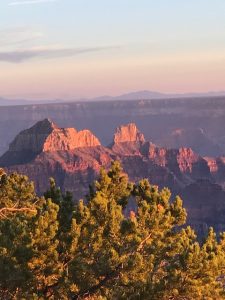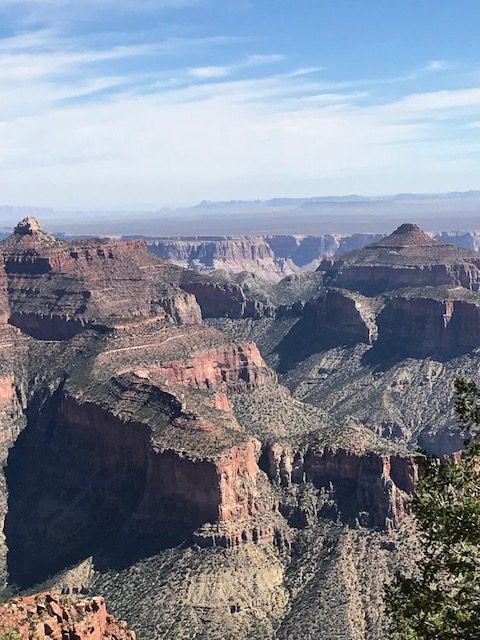When I was 30 I found my way to the Himalayas. It took me another 30+ to find my way to the Grand Canyon, pretty much the opposite of the Himalaya.
What to say about the Grand Canyon? Before going there this Summer I heard so many stellar reviews, I wondered if it could live up to them.
It more than did. And it added powerful inspiration to my view of healing.
Whether you’ve been there or not, lean back for a minute and come with me . . .
Imagine airy stillness. Not like still water, more like I imagine outer space. So still you can hear a raven’s foot steps. You can hear sounds of wind rustling pine needles miles away. You are deep in the earth. Big sky over expansive airspace between you and far-off cliffs. Parallel lines run thru them, between layer upon layer of ancient sea beds. Layers of prehistoric bedrock around you change color every few hours. Look up and watch the elegant soaring of condors, so high their gigantic wingspans are as minute as the canyon walls are massive.
Feel ancient rock, cool and sharp against your back as you lean into the shady hollow of a cliff. The dryness of the canyon can be hard to fathom from damper parts of the planet (like Baltimore!) But try to imagine air so dry your nose tingles every time you inhale. There’s also a gasp, like the tail end of a deep yawn, that shows up every time another view across the canyon opens up in front of you.
 Got it?
Got it?
We have a name for all these qualities in Asian Healing Arts: Metal. As in precious metal and gems that occasionally reveal their brightness and, often, remain buried in the earth. The Grand Canyon is a place where gems from underground are fully revealed. Along with the space that comes when all that obscured those gems is washed away.
We associate these qualities with the Autumn. The drying time after the Harvest. When the air gets crystal clear. And light gets a little sharper, especially at the angles that show up near dawn. The stillness of those early morning hours helps us clarify what’s essential so we can treasure it in the space that remains when we let go of all else. Yes, rain-bearing weather patterns sometimes delay the start of Autumn but they can’t prevent that cooling sigh that eventually shows up as we transition toward Winter.
What I learned in the Canyon is how this can unfold where there is a ‘fault,’ a vulnerable breakdown place that cracked and broke. I learned how broken places can, over time, give way to brilliant magnificence.
The Grand Canyon began when two bits of the planet’s surface collided. They were coming from slightly different angles, responding to pressures that had pulled and pushed for years (millions). The break came along a weak stretch, the Fault Line.
In the canyon, you can see where one set of these parallel lines meets another at a broad angle. The multi-colored layers of ancient sea beds are easy to distinguish, like a multi-level wedding cake. You can see just where two sections of the layer cake crunched together so hard their edges crumbled at their weakest point. This rupture exposed softer material that was under crustier surface layers. That’s where rushing snowmelt full of silt was able to erode away rubble. Leaving behind sheer bedrock beauty that draws people from all over the globe.
These images have stayed with me. I don’t always appreciate the force and friction of life’s crunchy bits as creators of great beauty. I’m not always as graceful as I might be about letting go of rubble that might allow my finer edges to shine – and catch all the colors of the sun’s daily spectrum!
 I’ve learned, over the years, that healing often takes us to points of collision buried deep within us. The places where conflicting pressures cause painful friction, sometimes so great that something has to give. A breaking point (fault line) can begin a creative process allowing those forces to play thru. Invariably, the mess of rubble this releases leaves behind tremendous beauty that is gem-level solid. Until we clarify and embrace our essential nature, we tend to hang onto all kinds of ‘rubble’ for fear we might throw out a baby with the bath!
I’ve learned, over the years, that healing often takes us to points of collision buried deep within us. The places where conflicting pressures cause painful friction, sometimes so great that something has to give. A breaking point (fault line) can begin a creative process allowing those forces to play thru. Invariably, the mess of rubble this releases leaves behind tremendous beauty that is gem-level solid. Until we clarify and embrace our essential nature, we tend to hang onto all kinds of ‘rubble’ for fear we might throw out a baby with the bath!
Breathing is key to this delicate balancing act between what stays and what goes. At least that’s the perspective of Asian Healing Arts. We say our lungs hold onto what is essential – our bedrock – and let go all else. Literally, our lungs function to hang onto what we need to survive til our next breath.
We see this honing process all around us in the natural world come Autumn. Trees draw in sap they need to survive the winter and let go of all else, including their leaves. It’s an edgy and severe balancing act.
The importance of of breathing at such edges was drop dead clear in the Canyon. Stepping around the corner of a cliff into a new view of the canyon took my breath away. It stopped me in my tracks – literally. Until my breathing rhythm kicked in again I could not lift a foot to take a single step. The drop-off just past the edge of the trail made me reel until my breathing settled. It wasn’t my head that felt dizzy, it was my abdomen. And it lasted until I drew breath that filled out that part of me. That was the only way to keep my balance between wide-open space on one side and solid rock on the other.
Breathe in. Breathe out. Slow, deep and even. It sounds so simple. It made a more noticeable difference in the Canyon. But I often say things that help us in a pinch help us even more if we practice them when things aren’t so pinchy.
Here’s to Autumn and to honing breathing practices that help us to navigate the edges in our lives. And here’s to embracing the friction around our fault lines.
Tune in next month for videos of some simple breathing practices to radically expand our lung capacity.

Cynthia Zanti Jabs, L.Ac., has practiced Acupuncture and Medical Qi Gong for two decades. She can be reached at her Ruscombe Mansion office by calling 443-226-6626.
